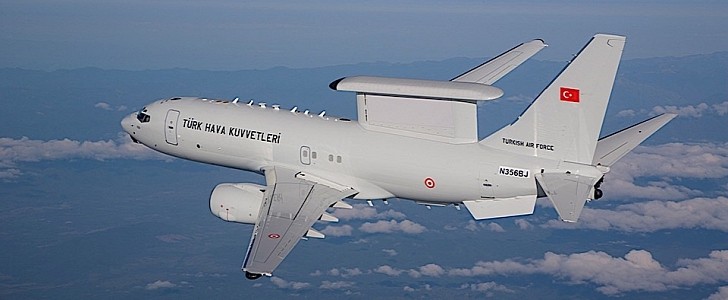Ever since the 1970s, a mighty flying platform has been used by the American military as a warning and control system. It’s the E-3 Sentry, a machine that is quickly approaching retirement age.
Made by Boeing and based on the 707 commercial airliner, the Sentry became a worldwide icon thanks to its 30 feet (9 meters) in diameter dish mounted on top of its fuselage. Better known as the AWACS (Airborne Warning and Control System), the plane is currently in the process of getting new capabilities, as proven by a recent electronic support measures test conducted earlier in April.
That isn’t stopping the Air Force from looking at the future though, and at a replacement for the AWACS. From 2023, part of the current fleet, which comprises in all a little over 30 airplanes, will have to be replaced.
The plane chosen to do that is also of Boeing make, namely the E-7 Wedgetail. Based on the 737, it’s lighter than the Sentry, and instead of the round dish up top, it features an elongated radar that runs parallel to the fuselage, hence its nickname.
Known in the industry as the Boeing Airborne Early Warning & Control (AEW&C), the Wedgetail comes with 360-degree sensor coverage ensured by the Northrop Grumman Multi-Role Electronically Scanned Array (MESA), is packed with gear making it capable to detect and geolocate targets, a state of the art comms system, and, of course, aerial refueling capabilities.
The plane’s gear makes it capable to identify friends and foes from a distance of 345 miles (555 km). It can fly for about 4,000 miles (6,400 km) on a single full of fuel, at altitudes of 41,000 feet (12,500 meters).
The Air Force plans to replace about half of the current Sentry fleet with the Wedgetail. So far, the airplane has been deployed in the service of the Royal Australian Air Force, and by the militaries of Turkey, South Korea, and the UK.
That isn’t stopping the Air Force from looking at the future though, and at a replacement for the AWACS. From 2023, part of the current fleet, which comprises in all a little over 30 airplanes, will have to be replaced.
The plane chosen to do that is also of Boeing make, namely the E-7 Wedgetail. Based on the 737, it’s lighter than the Sentry, and instead of the round dish up top, it features an elongated radar that runs parallel to the fuselage, hence its nickname.
Known in the industry as the Boeing Airborne Early Warning & Control (AEW&C), the Wedgetail comes with 360-degree sensor coverage ensured by the Northrop Grumman Multi-Role Electronically Scanned Array (MESA), is packed with gear making it capable to detect and geolocate targets, a state of the art comms system, and, of course, aerial refueling capabilities.
The plane’s gear makes it capable to identify friends and foes from a distance of 345 miles (555 km). It can fly for about 4,000 miles (6,400 km) on a single full of fuel, at altitudes of 41,000 feet (12,500 meters).
The Air Force plans to replace about half of the current Sentry fleet with the Wedgetail. So far, the airplane has been deployed in the service of the Royal Australian Air Force, and by the militaries of Turkey, South Korea, and the UK.







